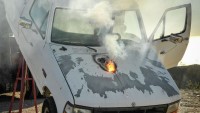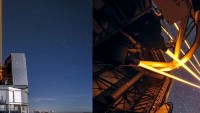Harvard 3-D Laser Printing Tech Prints Metallic Objects in Mid-air
| Arthur Dominic Villasanta | | May 17, 2016 06:17 PM EDT |
(Photo : Lewis Lab/Wyss Institute at Harvard University) Fragile metallic butterflies printed in mid-air with Harvard's laser-assisted 3-D printing technology.
Viewing the video that shows a laser-assisted 3-D printing machine using metallic inks create delicate objects suspended in mid-air leaves you speechless.
This fantastic laser-assisted direct ink writing method prints microscopic metallic, free-standing 3-D structures in one step, without auxiliary support material. It was developed by researchers at Harvard University's Wyss Institute for Biologically Inspired Engineering and the John A. Paulson School of Engineering and Applied Sciences (SEAS).
Like Us on Facebook
The research was led by Wyss core faculty member Jennifer Lewis, who is also the Hansjörg Wyss Professor of Biologically Inspired Engineering at SEAS.
Harvard said this fantastic technology could lead to customized electronic and biomedical devices. It said the increasing demand for flexible, wearable electronics, sensors, antennas and biomedical devices led a research team to innovate a jaw-dropping way of printing complex metallic architectures as though seemingly suspended in midair.
The laser-assisted direct ink writing method uses an ink composed of silver nanoparticles. The ink flows through a printing nozzle and is then annealed using a precisely programmed laser that applies just the right amount of energy to drive its solidification.
The printing nozzle moves along x, y, and z axes and is combined with a rotary print stage to enable freeform curvature. This method prints tiny hemispherical shapes, spiral motifs, even a butterfly made of silver wires narrower than a hair's width in free space within seconds. The printed wires also exhibit excellent electrical conductivity, almost matching that of bulk silver.
"I am truly excited by this latest advance from our lab, which allows one to 3-D print and anneal flexible metal electrodes and complex architectures 'on-the-fly,'" said Lewis.
Laser-assisted direct ink writing is superior to conventional 3-D printing because it allows the silver wires to be printed directly on low-cost plastic substrates.
It can produce sweeping curves and spirals and also sharp angular turns and directional changes written into thin air with silver inks. This technology opens-up nearly limitless potential applications in electronic and biomedical devices that rely on customized metallic architectures.
"The material is like toothpaste but made of silver. Toothpaste would be too floppy to hold its shape, but if you solidify it, you could hold it in midair," said Wyss Institute Postdoctoral Fellow Mark Skylar-Scott.
"We're no longer thinking about (3-D printing) as a layer by layer process. We still have gravity to fight, but now we can leave the substrate and go into free space."
Traditional 3-D printers slowly build objects by laying down successive layers of a material such as plastic and even food.
"This sophisticated use of laser technology to enhance 3-D printing capabilities not only inspires new kinds of products, it moves the frontier of solid free-form fabrication into an exciting new realm, demonstrating once again that previously accepted design limitations can be overcome by innovation," said Wyss Institute Director Donald Ingber, who is also the Judah Folkman Professor of Vascular Biology at Harvard Medical School and the Vascular Biology Program at Boston Children's Hospital, as well as professor of bioengineering at SEAS.
In addition to Lewis and Skylar-Scott, Suman Gunasekaran is a co-author on the study published in the Proceedings of the National Academy of Sciences. Gunasekaran is undergraduate researcher studying chemistry and physics at SEAS.
Tagslaser-assisted direct ink writing method, Harvard University, silver nanoparticles, Jennifer Lewi
©2015 Chinatopix All rights reserved. Do not reproduce without permission
EDITOR'S PICKS
-

Did the Trump administration just announce plans for a trade war with ‘hostile’ China and Russia?
-

US Senate passes Taiwan travel bill slammed by China
-

As Yan Sihong’s family grieves, here are other Chinese students who went missing abroad. Some have never been found
-

Beijing blasts Western critics who ‘smear China’ with the term sharp power
-

China Envoy Seeks to Defuse Tensions With U.S. as a Trade War Brews
-

Singapore's Deputy PM Provides Bitcoin Vote of Confidence Amid China's Blanket Bans
-

China warns investors over risks in overseas virtual currency trading
-

Chinese government most trustworthy: survey
-

Kashima Antlers On Course For Back-To-Back Titles
MOST POPULAR
LATEST NEWS
Zhou Yongkang: China's Former Security Chief Sentenced to Life in Prison

China's former Chief of the Ministry of Public Security, Zhou Yongkang, has been given a life sentence after he was found guilty of abusing his office, bribery and deliberately ... Full Article
TRENDING STORY

China Pork Prices Expected to Stabilize As The Supplies Recover

Elephone P9000 Smartphone is now on Sale on Amazon India

There's a Big Chance Cliffhangers Won't Still Be Resolved When Grey's Anatomy Season 13 Returns

Supreme Court Ruled on Samsung vs Apple Dispute for Patent Infringement

Microsoft Surface Pro 5 Rumors and Release Date: What is the Latest?













